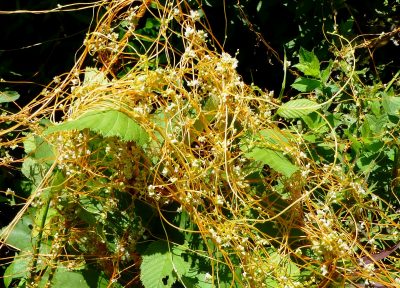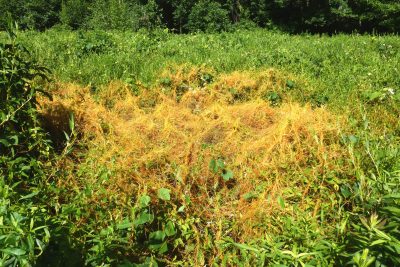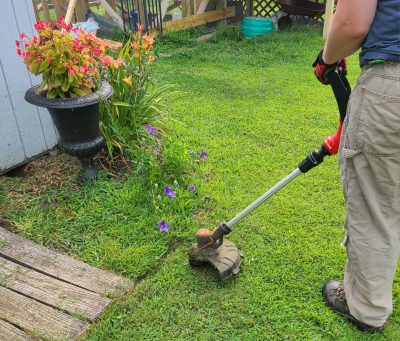By Pamm Cooper, UConn Home & Garden Education Center

Dodder is an obligate parasite of certain plants. This unusual member of the morning glory family is also known as “Angel’s Hair” and “Strangle Weed.” Like Indian pipe, another parasitic plant, Dodder has no chlorophyll to manufacture its own food, so nutrients and water are obtained from its host plant. Its yellow to orange twining stems can form stringy, dense orange mats that cover its host plants, and it will often climb over other nearby plants as well. This vine twines counterclockwise around stems and other parts of its host. Look for it in mid- July through September in damp fields or on stream and pond banks.
Dodder germinates from seeds produced in earlier years. The new plants have only a few days to find a suitable host plant, or they will die. After connecting with the host plant, dodder will degrade at the soil level where it originated and is then free of any soil contact. Dodder has no leaves or roots, but it does produce flowers and then seeds. The only way new plants can be re-established is from seed produced at least the previous year or even earlier.
Dodder feeds on its host by means of small tubes called haustoria that pierce into the hosts leaf or stem vascular system. One type will siphon water from the xylem, and another type will obtain food (minerals, sugars etc.) from the phloem of the host plant. In this way, dodder obtains essential nutrients and water for its own survival at the expense of its host plant. Five-angled dodder Cuscuta pentagona, a very common dodder species found here in Connecticut does not have specialized host plant preferences.
Since not all plants are suitable hosts for dodder, and because it needs to find a host quickly, dodder has a unique ability to “sniff out” certain plant chemicals and will gravitate toward these plants soon after germination. Notable hosts are jewelweed in the wild and tomatoes in crop cultivation. Thus, if you are interested in finding dodder, in July and August check out places where jewelweed abounds. Look for mats of orange, stringy vines covering the tops of this plant and perhaps on nearby Joe-pye weed and goldenrods.

Dodder seeds can survive in soil for twenty years or more and will germinate as conditions are suitable. Because of the longevity of its seed viability, dodder may be found either yearly in the same area or appear there years later. Flooding can also relocate the seeds, so it may appear along various spots along the same stream or pond. Look for its small white flowers appearing in clusters along the vine in late July and August.
Once dodder is firmly established on the host plant in the wild, research has shown that removal of the host plants and the dodder, especially before seeds are set on the dodder, will be more effective than other methods. This may need to be done yearly until any seed bank is exhausted. Try to scout early in July as dodder is getting established. Sometimes small dodder plants can be removed from the host. Some people with dodder persisting in extensive areas have burned these sites, and this will also severely impact any seeds on the ground.
Dodder is an aggressive plant, but it is not considered invasive because it is a native plant. It has received the dubious honor of making the Federal List of Noxious Weeds, though. Although its hosts may be severely weakened, dodder does not always kill its host. While that is not reasonable cause to let it run rampant in a garden, in the wild it is in more of a tournament for survival. May the best plant win…
The UConn Home & Garden Education Center supports UConn Extension’s mission by providing answers you can trust with research-based information and resources. For gardening questions, contact us toll-free at (877) 486-6271, visit our website at homegarden.cahnr.uconn.edu, or reach out to your local UConn Extension center at cahnr.uconn.edu/extension/locations.
This article was published in the Hartford Courant September 1, 2025
